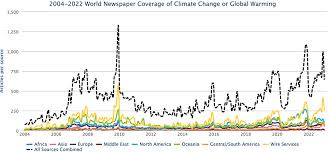In the fast-paced world of digital media, eco-focused news platforms have been Traffic riding a wave of growing interest in sustainability and climate issues. Among them, The Cooldown, a U.S.-based news site dedicated to climate and sustainability, has been a standout, gaining traction with its fresh take on environmental stories. However, despite its earlier success, recent data shows The Cooldown is experiencing a significant drop in web traffic, raising questions about the challenges facing niche news outlets in 2025. What’s behind this decline, and what does it mean for the future of eco-focused journalism?
A Bright Start for The Cooldown
Launched with a mission to make climate news accessible and actionable, The Cooldown quickly carved out a space in the crowded digital news landscape. According to Press Gazette, the site saw an impressive 71% year-on-year traffic increase in April 2025, reaching 27.8 million visits. This growth was fueled by a surge in public interest in sustainability, as more people sought practical solutions to combat climate change. From tips on reducing carbon footprints to deep dives into renewable energy innovations, The Cooldown positioned itself as a go-to source for eco-conscious readers.
The site’s success wasn’t just about numbers. Its mobile-friendly design, engaging multimedia content, and AI-driven personalization helped it rank well on platforms like Google Discover and Apple News. By focusing on “explainers” that break down complex environmental topics into easy-to-understand articles, The Cooldown appealed to a broad audience, from eco-enthusiasts to everyday readers curious about green living. But despite this strong start, recent months have told a different story.

The Traffic Drop: What’s Happening?
Recent reports indicate that The Cooldown has seen a noticeable decline in web traffic, mirroring a broader trend affecting many news websites in 2025. While exact figures for The Cooldown’s latest traffic numbers are not publicly available, industry insights from sources like Search Engine Land and Trak.in suggest that news sites, particularly those reliant on search engine traffic, are facing steep challenges. A study by TollBit found that news sites and blogs are receiving up to 96% less referral traffic from AI-powered search engines compared to traditional Google searches. This shift is hitting eco-focused platforms like The Cooldown hard, as they compete for visibility in an increasingly AI-driven digital ecosystem.
So, why is this happening? Several factors are at play:
1. The Rise of AI-Powered Search
Google’s AI Overviews, along with tools like OpenAI’s ChatGPT and Perplexity, are changing how people consume information. These platforms often provide direct answers to user queries, reducing the need to click through to websites. For example, a user searching for “ways to reduce plastic waste” might get a concise answer from an AI tool, bypassing articles on The Cooldown. This trend is particularly damaging for niche sites that rely heavily on organic search traffic. Carly Steven, SEO director for MailOnline, noted a “shocking” 56% drop in click-through rates when AI Overviews appear, even for top-ranking sites.
2. Shifting Reader Habits
Consumer behavior is evolving, with many readers gravitating toward short-form content like videos or social media posts. While The Cooldown excels at creating in-depth articles, it may struggle to compete with platforms like YouTube or Instagram, where users spend an average of 20 minutes per visit. Eco-focused content often requires detailed explanations, but attention spans are shrinking, and readers may prefer quick tips over long-form journalism.

3. Increased Competition
The eco-news space is getting crowded. Major news outlets like The New York Times and BBC, which saw traffic gains in 2025, are expanding their climate coverage, drawing readers away from smaller players. Additionally, new platforms and influencers on social media are offering bite-sized sustainability content, making it harder for The Cooldown to stand out. Even though the site grew by 71% year-on-year earlier this year, maintaining that momentum is proving difficult in a saturated market.
4. Algorithm Changes and SEO Challenges
Google’s algorithm updates, such as the December 2024 spam update, have also impacted traffic for many websites. Sites like The Cooldown that rely on search engine optimization (SEO) to drive visitors may have been affected by these changes. Google’s shift toward prioritizing “user-focused content” means that sites must constantly adapt to stay visible. If The Cooldown’s content isn’t aligned with the latest SEO best practices, it could lose ground to competitors.
The Bigger Picture: Challenges for Eco-Focused News
The Cooldown’s traffic drop reflects broader challenges for eco-focused news platforms. While public interest in climate issues remains high—driven by events like extreme weather and global policy debates—translating that interest into sustained web traffic is tricky. Many readers are “choiceful” in their media consumption, seeking quick, actionable insights rather than in-depth analysis. This shift mirrors trends in other industries, like retail, where Target reported a 3.8% sales drop in 2025 as consumers focused on budget-friendly, needs-based purchases.
Moreover, eco-focused news sites face unique hurdles. Climate content often competes with sensational political or celebrity news, which tend to dominate traffic rankings. For instance, Press Gazette reported that American and Canadian political news sites saw significant traffic gains in March 2025, while many other news categories, including global and niche topics, saw declines. The Cooldown’s focus on sustainability may struggle to compete with the viral appeal of hard news or entertainment.
What Can The Cooldown Do to Bounce Back?
Despite the challenges, there are steps The Cooldown can take to regain its footing and continue its mission of promoting sustainable living. Here are some strategies that could help:
1. Lean Into Branded Content
Experts like Carly Steven from MailOnline suggest that news sites focus on “unreplicable” content, such as exclusive interviews, live blogs, or unique perspectives. The Cooldown could invest in original stories, like profiles of eco-innovators or firsthand accounts of climate solutions in action. By building a strong brand identity, the site can attract loyal readers who seek out its content directly, rather than relying on search engines.
2. Embrace Short-Form and Social Media
To capture younger audiences, The Cooldown could expand its presence on platforms like Instagram and TikTok, where eco-conscious influencers thrive. Short, engaging videos on topics like “5 Ways to Go Zero-Waste” or “What’s New in Solar Energy” could drive traffic back to the site. This approach aligns with the success of platforms like YouTube, which remains a top destination for user engagement.

3. Optimize for AI Search
To combat the impact of AI-powered search tools, The Cooldown could embed FAQ sections with structured data (schema) to ensure its content appears in AI-generated answers. This strategy, recommended by Search Engine Land, helps brands “own” the answer even if users don’t click through. Additionally, focusing on middle-of-the-funnel (MOFU) and bottom-of-the-funnel (BOFU) content—such as guides or product recommendations—could boost conversions and engagement.
4. Diversify Traffic Sources
Relying solely on search engines is risky. The Cooldown could explore partnerships with platforms like Apple News or Google Discover, where it has previously performed well. Additionally, collaborating with eco-focused influencers or brands could drive referral traffic. Recent data shows that Facebook is regaining traction as a traffic source for publishers, offering another avenue for growth.
Looking Ahead: The Future of Eco-Focused News
The traffic drop faced by The Cooldown is a wake-up call for eco-focused news outlets, but it’s not the end of the road. Climate change remains a pressing global issue, and demand for reliable, actionable information is unlikely to fade. By adapting to changing reader habits, embracing new platforms, and staying ahead of SEO trends, The Cooldown can reclaim its momentum.
For now, the site’s experience highlights the challenges of staying relevant in a digital landscape dominated by AI, short attention spans, and fierce competition. Yet, with its mission-driven focus and loyal audience, The Cooldown has the potential to not only recover but also lead the way in making sustainability news accessible to all. As the world grapples with environmental challenges, platforms like The Cooldown play a vital role in informing and inspiring action—one reader at a time.
Sources: Press Gazette, Search Engine Land, Trak.in
Read More :- Gen Z’s Tanning Trend Sparks Public Health Concerns in the USA






